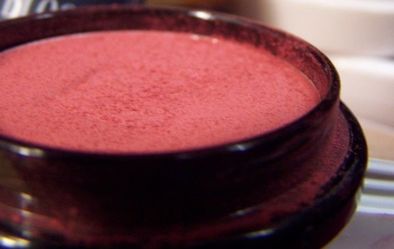|
Rouge (aka blush) is the longest-standing makeup item in existence. It not only was put on cheeks, but also lips (not to be confused with lipstick). As we did with eyeliner, we are starting with the Egyptians. As the Egyptians were sophisticated chemists, they blended ingredients such as red ochre, or chocineal (small red bugs) with animal or vegetable fats to create sticks of rouge. You can imagine the green eye shadow and black kohl liner from the previous article in the series mixed with a deep rouge made for a strong and striking face.
Roman men and women also wore blush. They used lead paint. Silly Roman's, lead poisons you! They also would have a servant spit into their cheek powder before applying to make sure it was the correct level of pasty. In places like Japan and China rouge was used in Kabuki and opera. The red stood out against the white faces painted on the performers. In Western Europe, during the reign of Elizabeth I, once you had applied your pale white lead (lead again?!) to your face you rouged your cheeks with a daub of red. You couldn't smile after applying your white and red or else the hardened makeup would crack. I wonder if that is where "to crack a smile" came from... The Northern Renaissance makeup wearers not only put deadly eye drops in their eyes (if you forgot read here) but they also put mercuric salts on their cheeks. These came from mercury. All you need to remember is lead and mercury are bad. Don't put them on or in you, ever! In the Directoire period some men known as Incroyables used rouge to heighten their color. Besides this most makeup was seen as "improper". Any obvious sign of rouge during the Romantic Period was seen as "painting" and shunned. During the Crinoline Period makeup was still seen as "improper" so women would pinch their cheeks to cause more blood flow to their cheeks, making them redder for a short time. Watch "Gone with the Wind" it happens in that movie a lot. Not until the 1920's did rouge come back into fashion. Flappers not only rouged their cheeks, but some would also rouge their knees; think Chicago. Following decades brought different shades of rouge, some bright red, other subdued choral. Each decade had a different view of makeup. 1960's and 1980's were bright and bold, while the 1970's celebrated a more "natural" makeup look. Throughout history blush/rouge came in many forms. It has been a powder, a stick, greasy, or a stain. Sometimes it has been made of ochre, bugs, or beet juice. Today some celebrities such as Shailene Woodley use beet juice as lip stain, but you can also use it as cheek stain! Here is an article and recipe from Bustle. References:
0 Comments
Leave a Reply. |
Topics
All
Archives
July 2021
|

